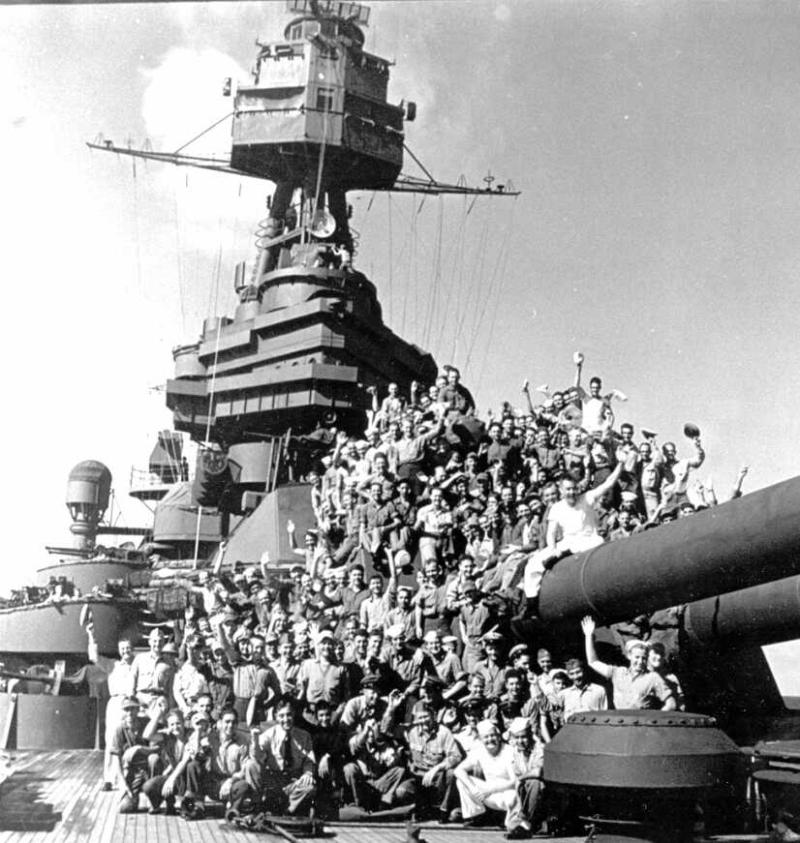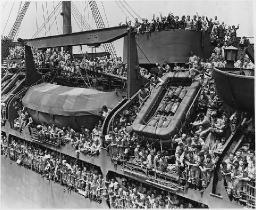Returning the Military After WW2



Returning the Military After WW2
These are the most incredible pictures of the returning military from World War 2. This is proof of history you'll probably never see in children's school books today - pictures worth 1,000 words. Remember what Eisenhower said at the end of the war, "Take pictures of the dead Holocaust Jewish people, a generation or two will never believe it happened"
Returning the troops home after WWII was a daunting task....The Magic Carpet that flew everyone home. In 1939, there were 334,000 servicemen, not counting the Coast Guard. In 1945, there were over 12 million, including the Coast Guard. At the end of the war, over 8 million of these men and women were scattered overseas in Europe, the Pacific and Asia. Shipping them out wasn't a particular problem but getting them home was a massive logistical headache. Army Chief of Staff General George C. Marshall had already established committees to address the issue in 1943.

Soldiers returning home on the USS General Harry Taylor in August 1945.
When Germany fell in May, 1945, the US. Navy was still busy fighting in the Pacific and couldn't assist.
The job of transporting 3 million men home fell to the Army and the Merchant Marine.
300 Victory and Liberty cargo ships were converted to troop transports for the task.
During the war, 148,000 troops crossed the Atlantic west to east each month; the rush home ramped this up to 435,000 a month over 14 months.

Hammocks crammed into available spaces aboard the USS Intrepid.
In October 1945, with the war in Asia also over, the Navy started chipping in, converting all available vessels to transport duty.
On smaller ships like destroyers, capable of carrying perhaps 300 men, soldiers were told to hang their hammocks in whatever nook and cranny they could find.
Carriers were particularly useful, as their large open hangar decks could house 3,000 or more troops in relative comfort, with bunks, sometimes in stacks of five welded or bolted in place.

Bunks aboard the Army transport SS Pennant.
The Navy wasn't picky, though: cruisers, battleships, hospital ships, even LSTs (Landing Ship, Tank) were packed full of men yearning for home.
Two British ocean liners under American control, the RMS Queen Mary and Queen Elizabeth, had already served as troop transports before and continued to do so during the operation, each capable of carrying up to 15,000 people at a time, though their normal, peacetime capacity was less than 2,200.
Twenty-nine ships were dedicated to transporting war brides: women married to American soldiers during the war.

Troops performing a lifeboat drill on board the Queen Mary in December 1944, before Operation Magic Carpet.
The Japanese surrender in August,1945, came none too soon, but it put an extra burden on Operation Magic Carpet.
The war in Asia had been expected to go well into 1946 and the Navy and the War Shipping Administration were hard-pressed to bring home all the soldiers who now had to get home earlier than anticipated.
The transports carrying them also had to collect numerous POWs from recently liberated Japanese camps, many of whom suffered from malnutrition and illness.

U.S. soldiers recently liberated from Japanese POW camps.
The time to get home depended a lot on the circumstances. USS Lake Champlain, a brand new Essex-class carrier that arrived too late for the war, could cross the Atlantic and take 3,300 troops home a little under 4 days and 8 hours.
Meanwhile, troops going home from Australia or India would sometimes spend months on slower vessels.

Hangar of the USS Wasp during the operation.
There was enormous pressure on the operation to bring home as many men as possible by Christmas, 1945.
Therefore, a sub-operation, Operation Santa Claus, was dedicated to the purpose.
Due to storms at sea and an overabundance of soldiers eligible for return home, however, Santa Claus could only return a fraction in time and still not quite home but at least to American soil.
The nation's transportation network was overloaded, trains heading west from the East Coast were on average 6 hours behind schedule and trains heading east from the West Coast were twice that late.

The crowded flight deck of the USS Saratoga.
The USS Saratoga transported home a total of 29,204 servicemen during Operation Magic Carpet, more than any other ship. Many freshly discharged men found themselves stuck in separation centers but faced an outpouring of love and friendliness from the locals. Many townsfolk took in freshly arrived troops and invited them to Christmas dinner in their homes.
Still others gave their train tickets to soldiers and still others organized quick parties at local train stations for men on layover.
A Los Angeles taxi driver took six soldiers all the way to Chicago; another took another carload of men to Manhattan, the Bronx, Pittsburgh, Long Island, Buffalo and New Hampshire. Neither of the drivers accepted a fare beyond the cost of gas.

Overjoyed troops returning home on the battleship USS Texas.
All in all, though, the Christmas deadline proved untenable. The last 29 troop transports, carrying some 200,000 men from the China-India-Burma theater, arrived to America in April, 1946, bringing Operation Magic Carpet to an end, though an additional 127,000 soldiers still took until September to return home and finally lay down the burden of war.
Tags
Who is online
33 visitors

I am unable to post a source, because this was sent to me in an email by my brother, who was a Lieutenant in the Royal Canadian Navy. However, is there anyone here who could possibly think this is false news?
From the pictures, it looks pretty authentic.
After what most of them had been through, I suppose the long lines for chow and the latrine were endured with good humor and probably a lot of jokes.
Found it ! Looks legit to me !
Good article. Two of my fathers brothers came back this way.
My father was stuck in Dresden and other places as an MP for a year.
Just a little follow-up footnote:

"The USS Saratoga transported home a total of 29,204 servicemen during Operation Magic Carpet, more than any other ship. Many freshly discharged men found themselves stuck in separation centers but faced an outpouring of love and friendliness from the locals."
The Saratoga had received 8 battle stars for her service in WWII. After the war the Navy had to downsize. The USS Saratoga (CV3), with it's full contingent of planes was anchored off Bikini Atoll along with many other ships to be used as part of a series of nuclear tests:
"Operation Crossroads began with the first blast (Test Able), an air burst on 1 July 1946. Saratoga survived the explosion with only minor damage, including the ignition of the teak of her flight deck. A skeleton crew boarded Saratoga the following day to prepare her for the next test on 25 July. The ship was sunk by Test Baker, an underwater blast which was detonated under LSM-60 400 yards (370 m) from the carrier. The force of the explosion lifted the vessel out of the water, knocked everything off her flight deck and knocked most of her funnel onto the flight deck. [117] She was struck from the Naval Vessel Register on 15 August 1946. [1]"
The Saratoga today.